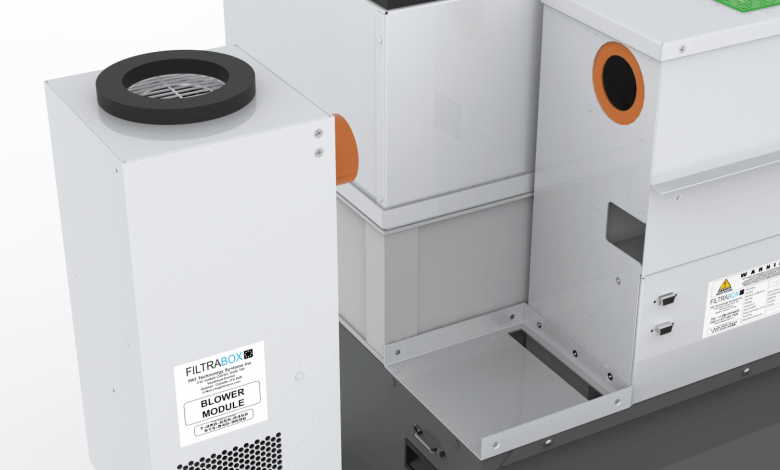Clearing the Air: Keeping Your Workplace Clear of Harmful Fumes and Particulates
There are many different types of systems; make sure you get the one that's right for your shop.
Air purification or fume extraction systems are an important piece of any business, especially if their equipment spews noxious fumes or fine particulates into the air.
It isn’t enough to just vent these fumes outside, says Kevin East, president for Fumex LLC, because that is “not purifying or capturing any of the harmful particulates generated in the process or protecting the environment.”
Wayne Baird, president of PAT Technology Systems Inc., says there are two types of fume extractors: one is connected to the host by a hose and the other is a whole room purifier. There are roof purifiers as well, but Baird doesn’t believe they do a good job because “by the time the odor or particulate is in the room, it is too late,” he says.
PAT Technology Systems has been in the business of air purification since 1998 when PAT stood for printing air technology. At that time, the company focused its attention on air quality in print shops.
“It originally started out as a means of ensuring high-quality output for the printer and the printer’s customer,” Baird says. It then evolved as the industry evolved. In the 1990s, that meant more focus on the health of the worker and the health of the business by extracting volatile organic compounds from the air, particularly in those businesses that used solvent-based inks.
Many sign companies still use solvent and eco-solvent inks, but others have transitioned to UV ink because it doesn’t have as strong of an odor as other types of inks.
“I strongly recommend any printer to review the MSDS (material safety data sheets) sheets, certainly the engineering or cautionary notes, to decide whether or not fume extraction or air purification is needed or not. I have a bias obviously. I think most inks need to be captured,” Baird says.
If a company decides to invest in a fume extraction, recirculating or air purification system, the benefits are clear, he says. The air in the room is circulated through filters and then put back in the room instead of venting to the outside.
The pre-filter picks up larger particulates. The HEPA filter picks up the fine particles and the carbon filter takes up the gas that radiates off the process and keeps the odor down.
Some manufacturers combine the HEPA and carbon filters into one.
“This is one of my pet peeves,” says Baird. “I know that it is impossible for the HEPA filter and the carbon filter to be saturated at the same time; it is an impossibility.” He believes it is a waste of money to replace “a good filter for no particular reason.”
Many machines do have sensors on them to let the operator know a filter needs to be replaced but, Baird says, the best sensor is the operator’s nose. “Once you smell something, there is a breakthrough. That means it is time to change the carbon.”
In the filtration business, size matters.
“The bigger the machine, the bigger capacity filters you buy and the less often you have to change them. You have to take a look at how you address your capital and operational budgets; essentially the bigger the filter, the better. It means you won’t have to change it on a regular basis as you would on a smaller one,” he adds.
Fumex works closely with laser manufacturers. Instead of conducting a machine’s exhaust outdoors, these companies hook up Fumex blowers and filtration to the machines and clean the air, which not only protects the machine operator from unwanted fumes but the optics and machinery itself, East says.
Fume extractors can be fairly small. Fumex’s systems range from 20 inches to 35 inches tall.
“A lot depends on the size of the laser, how we size our systems and usage. We can put different filters into place depending on the materials they are processing,” he says.
Fumex fume extractors are simple, plug and play devices. They are also easy to operate and maintain, he adds.
The fume extractors will alert the operator when it is time to replace filters. Like PAT Technology Systems, Fumex’s devices also have three filters. Filters need to be replaced more frequently when more difficult substrates are being carved. If the material is sticky, the filters will have to be changed more often. Those that emit dry particulates, like glass, will get significant life out of their filters.
“Overall, air quality is such a big issue with OSHA and the work environment. It is important to have a safe working environment,” says Fumex’s East.
Another big plus to using an air purification system is that a shop doesn’t have to have makeup air. That means keeping the cool air inside during the summer months and the hot air inside during the winter months because it isn’t constantly being pumped out of the vent.
East says that many local communities are beginning to crack down on businesses that vent unfiltered emissions to the outdoors, particularly in certain parts of the country that are more environmentally conscious.
“Fume extractors are not expensive compared to the laser systems themselves. The biggest issue operators of these businesses have is they don’t have a cost associated with the filtration part of it when they are venting outdoors. That’s the biggest change for operations. That is easily offset by protecting the environment, operators and reduced electrical costs,” he says.




